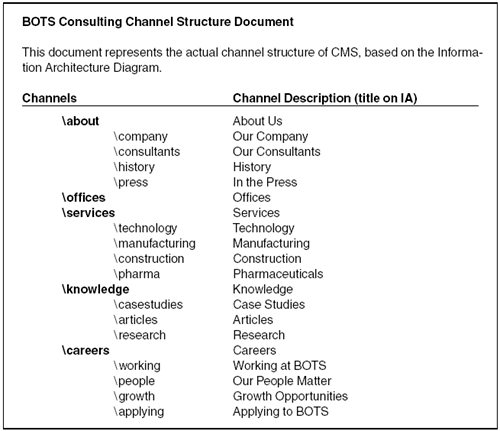Information Architecture Review and Template Design
| Without a doubt, the most important aspect of a Web site is the information architecture. The IA defines how information is organized on your site from the relationship between pages to the organization of information within a page. Whether or not you've consciously developed an IA, every site has one. Although some sites have a more logical and clear IA, moving to CMS will solidify the IA of your site, removing ambiguity caused by content contribution. As a result, it's a good idea to fully review and document an IA before moving your site to CMS. The first step in creating a formal IA is to develop an information architecture diagram. This diagram, sometimes loosely referred to as a site map, is the equivalent of an organizational chart for your site. It shows all the content categories and all the pages, determines the nomenclature for these items, and illustrates where each page or category will be housed (under what parent category). Truly, the IA becomes a map of how end users get from point A to point B. Now, the IA isn't just the site diagram. In addition, the IA includes page layout. Sometimes called schematics or wire frames, these documents illustrate the layout of content and functionality within a particular page (a posting, in CMS terms). Where is the search field? Where and how does the global navigation appear? These questions and many others are answered by the page schematics. More than a few companies have viewed IA development as trivial, but it is generally more complicated than most firms expect. Within the context of a CMS implementation, these exercises have a tremendous impact on the project's success. The mere nature of CMS removes some of the arbitrary nature of site development. For example, when developers are in complete control, they can make decisions about nomenclature, site structure, and page layout as they code; when you have many developers working on the project, you may end up with different interpretations of nomenclature and layout. However, CMS reduces these inconsistencies by providing one place to retrieve the site organization (channel structure) and by implementing a template structure. The templates, in turn, are used by the content contributors to create pages within the site. The channel structure is what the developed code reads to display the navigation on the site. This is not to say that CMS reduces site flexibility. In fact, CMS sites can be extremely flexible. CMS simply creates a constant environment for end users, content contributors, and developers, and consistently reinforces this structure no matter how much content is added. Earlier in this chapter, we discussed the content and functionality inventory. Those two documents will serve as the foundation for all of the work you'll perform in this phase. In fact, in conjunction with the content inventory, the IA may point out what content needs to be removed, "fixed," or added. At BOTS Consulting, the business users developed the information architecture shown in Figure 37-1. Figure 37-1. Sample information architecture for BOTS Consulting
Once the information architecture is developed, you can directly translate that into a channel structure in CMS. Whereas the IA is the logical organization of your content, the channel structure represents the physical storage. In addition, as you have seen in prior chapters, the channel structure forms the foundation of your site's navigation. If we were to translate the information architecture for BOTS Consulting into a channel structure, it might look something like Figure 37-2. Figure 37-2. BOTS Consulting channel structure
In the figure, you can see how the IA was translated into the channel structure. The IA descriptions become the channel Display Name property, and the channel name is a shortened version of the description. Also notice that although there may be items listed on the IA (links to pages or channels) more than once, they will not be listed in the channel structure in the same way; remember, the channel structure is the physical representation of a logical architecture a navigation element may appear logically in more than one place, but it will be physically represented only once. |
EAN: 2147483647
Pages: 298

